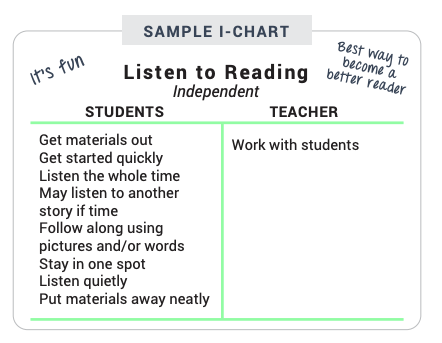Step 3—Record Desired Behaviors
Join Our Community
Access this resource now. Get up to three resources every month for free.
Choose from thousands of articles, lessons, guides, videos, and printables.
This video is a perfect opportunity to learn from my mistakes so you can avoid making them yourself.
The purpose of the lesson is to introduce Listen to Reading. I begin by identifying what is to be taught and write it on the I-chart. For the first minute, things are going well and I feel like a good teacher.
Then I ask students to tell me why they think we listen to reading. No one can answer the question. After restating it, with the same result, I finally tell them why.
At the 1:55 mark, I ask, “What would it look like, sound like, and feel like if you were being independent while Listening to Reading?” The brainstorming lasts for the remainder of the video—yes, eight minutes of brainstorming! But if you really listen to what is happening, you’ll notice that in addition to getting desired answers, I am addressing what happens when a computer has a pop-up, asking students to put their hands down, and explaining the sites that they will be using for Listen to Reading—twice. Joshua’s last question, “Can you play anything you want with the computer?” was especially frustrating because we’d discussed this in our lengthy brainstorming session. Either he didn’t understand it or, as we’ve since learned about how the brain works, he couldn’t attend to the instruction anymore.
Because of the nature of this discussion, students felt free to add any thought that came into their heads. It would have been far more effective if I had just identified the behaviors we were looking for, modeled, and gave them opportunity to practice. It is the biggest reason we don't brainstorm behaviors anymore. We keep our lessons short by explicitly stating and explaining what students will be doing.
Here is what you would see today if you walked in while we were teaching Listen to Reading using the 10 Steps to Teaching and Learning Independence.
Step 1: Identify what is to be taught. “Today we are going to launch Listen to Reading.” We write “Listen to Reading” on our I-chart.
Step 2: Create a sense of urgency. “Class, the reason we do Listen to Reading is that it helps us become better readers. It helps build our stamina, provides fluent examples, expands our vocabulary, and is really fun!”
 Step 3: Record the most desirable behaviors. We write the following behaviors on the I-chart as we say, “When you are Listening to Reading and doing it independently, you will
Step 3: Record the most desirable behaviors. We write the following behaviors on the I-chart as we say, “When you are Listening to Reading and doing it independently, you will
- get started right away,
- stay in one spot,
- listen the whole time,
- listen quietly,
- work on building your reading and listening stamina,
- persevere, and
- ignore distractions.”
There you have it: the old way and the new way. It takes just about four or five minutes to introduce the first three steps of the 10 Steps to Teaching and Learning Independence. It took us years to make the change. If you learn from our journey, you’ll have learned the same lesson in just 10 minutes.






